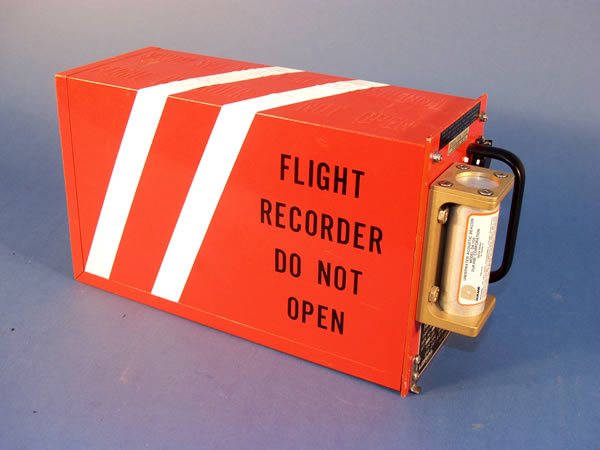Amongst volumes on Dali, Francis Bacon and Helmut Newton,
J.G. Ballard’s library also contained The Black Box
(1984) edited by Malcolm MacPherson. The book is a collection of transcripts
taken from the Flight Data Recorders of aeroplanes involved in “air disasters”.
These ‘black boxes’, consist of a central recording medium (first wire,
then tape, now currently digital matter) sealed in a steel outer casing that is
robust enough to survive high impact, intense heat and immersion in water. The
devices are typically installed into a plane’s tail assembly in order to record
in-flight instrument data and cockpit dialogue. In the event of a crash the
units can, in theory, be recovered intact from the wreckage in order to
reconstruct the sequence of events – computational and conversational – that
preceded the accident.
The Flight Data Recorder has been an industry standard
since 1960. Versions have been in use since 1939 but mainly in the aircraft
research industry. It was first outlined for use in civilian aviation with a
specific post-crash application in 1954 by David Warren, an aeronautical
researcher at the Australian Defense Department. His paper, “A Device for Assisting Investigation into Aircraft
Accidents” streamlined the problematic photographic functionality of previous
models and gave rise to the 1957 prototype, the Flight Memory Unit. At this
point in the object’s history, ‘black box’ can be revealed as something of a
misnomer: the devices were designed to be, and have remained, bright orange to
facilitate ease of identification and retrieval on the ground. The term seems
to have stuck due to journalistic shorthand and possibly as a residue of its
initial photographic incarnation. Early models were essentially small, sealed
darkrooms not designed with crash salvage in mind.
Although technically imprecise, ‘black box’ nevertheless
carries accuracy as regards the imaginative significance invested in the device.
In circuit design, ‘black box’ describes a component that is understood not on
the basis of its mechanism but in relation to its input, output and
processional characteristics, the manner in which the input changes as a result
of its transfer through the device. Similarly, the Flight Data Recorder often
occupies the interstitial position common to the symbolic reception of many
recording devices: it hovers as an invisible mediator somewhere between
operation and content. Frequently brandished
for the press at the edge of an accident zone, the recorder is often taken as a
talismanic marker that signals not the start of an analysis but the completion
of an investigation. A solid state amongst the residue of the plane, the black
box functions as a perfect synecdoche: one surviving part that at a human and
material level, can reassemble the disintegrated whole. Once it is found, the
external reportage can withdraw as the public narrative of the plane crash has,
in a sense, come to an end.
John Varley’s short story ‘Air Raid’ (1977) and later novel
Millennium
(1983) are both built upon this symbolism of holistic resurrection. In each, a
black box is recovered containing a recording that analeptically opens out at
an exponential rate. It narrativizes the crash central to each text, as well as
a panoramic scenario of time travel and impending catastrophe. Varley’s box is
a narrative engine that quickly disappears under the weight of its contained
significance. For Ballard, his attraction to the device is also connected to
its narrative results. Writing in a 1998 review of MacPherson’s second edition,
he explains that his fascination with the transcripts lies in their
presentation of slowly accumulating decline:
What stands out […] is how quietly
catastrophe creeps up on its victims. A gradual fall in hydraulic pressure, an
unexplained loss of fuel, a hint of smoke in a lavatory, are noted half an hour
before the looming crisis.
However, what is also emphasised in Ballard’s account is the
informational poverty that the neutral ear of the recorder necessarily retains.
As Iain Sinclair noted when describing the myth of Ballard’s own archive,
‘nothing intimate survive(s)’:
[…] the transcripts convey only the
sketchiest impression of the atmosphere in a stricken aircraft as the captain
and crew wrestle with their controls. While one crippled system collapses on
another, horns blare, lights flash and recorded voices shout: "Pull up!
Pull up!"
Yet no one panics. Even in the final moments, as the doomed aircraft heads
towards the ground at 400 miles per hour, only a stoical regret is sounded,
like the simple comment, "We're dead", made by the co-pilot of a
Lockheed cargo plane in the seconds before the end.
That final announcement encapsulates the (im) possibility of
the black box. Along with examples such as Edison’s spiritualist hopes for his
phonograph and Konstantin Raudive’s fascination with Electronic Voice
Phenomena, the imaginative economy of the Flight Data Recorder helps to
maintain the post-mortem fantasy associated with recording media. It seems to
work against annihilation by preserving voice and experience in the aftermath
of their destruction. And yet, what Ballard highlights is the skeletal,
denotation of ‘the end’. It exists and can, of course, only exist as a
statement of an impending event rather than a survival of the event itself. The
investigative specificity of the Flight Data Recorder coupled with the nature
of its most significant material foregrounds the operational reality that
underpins the projected phantasy: a capacity for re-play rather than
mediumship.

No comments:
Post a Comment